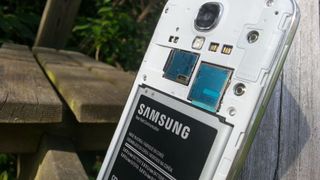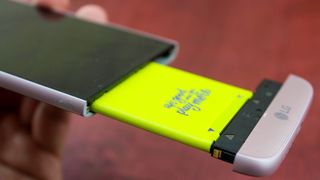The impossible dream: perfecting smartphone battery life
A change is coming, but not fast

It’s been a decade since the original iPhone launched, revolutionizing personal computing as we know it. While Apple’s iconic handset changed the way we all interacted with personal electronics forever, it wasn’t perfect. Actually, one element of the phone - its battery life - was positively woeful.
Despite handset technologies continuing to develop at a rapid rate, with flagship phones being replaced year after year by new, superior siblings, the original iPhone’s biggest problem - shoddy staying power - remains in the iPhone 7 and its rivals.
Chipsets continue to get faster, camera megapixel counts continue to go up and ever increasing amounts of RAM and internal storage are squeezed in, leading to remarkable handsets like the Samsung Galaxy S8 and Sony Xperia XZ Premium. Battery life, however, has stagnated at the single day mark, 36 hours max if you’re lucky.
Those pipe-dream promises of week-long batteries we’ve all coveted for the past decade appear no closer to reality than they were that day back in 2007, when Steve Jobs told us all we’d have to charge our phones every night.
Why though are smartphone batteries so slow to develop? We asked a number of industry experts to find out and discover just how far away that perfect smartphone battery really is.
Chasing the impossible dream
Improving battery life shouldn’t be that difficult, right? Just make the battery bigger, or invest some of those billions of dollars of profit that the smartphone space is rolling in to boost battery development. Sounds simple.
Unfortunately, things aren’t that straightforward. Developing a new battery isn’t just about splashing the cash, hiring the best scientists and engineers, or even the passage of time. Unlike advancing processing power, which follows a pre-set path, creating more energy dense batteries requires creating whole new fields of science.
Get the best Black Friday deals direct to your inbox, plus news, reviews, and more.
Sign up to be the first to know about unmissable Black Friday deals on top tech, plus get all your favorite TechRadar content.
“Processing power tends to follow something we call Moore’s Law, so every few years transistors get slightly smaller and therefore we can fit more onto a chip and get more processing power,” explained Dr. Billy Wu, an Electrochemical Science and Engineering lecturer at Imperial College London’s Dyson School of Engineering.
“In microprocessors, it’s all about making things smaller. In lithium-ion batteries, if you want to get an improvement in energy density, so how long your phone lasts, then you need to fundamentally change the materials that you put inside of it.”
This isn’t as easy as simply switching out certain chemicals in favor of others. Instead it’s a carefully balanced concoction of components that if mismanaged could be seriously dangerous.

“At the moment we use NMCs, those nickel, cobalt, manganese combinations, and in the next few years we’ll have an energy density increase just by tweaking the ratios of the elements we put in,” he explained.
“We will get more energy by putting more nickel inside because it’s a more reactive element. That will happen in the next few years. We are slowly solving it.
“These progressions, we’re using the same materials so can slot that into the same manufacturing lines right now as we use the same equipment. That will give you an order of maybe 10 or 20% extra performance.”
A 10-20% improvement in battery life is nothing to be sniffed at, that will edge you into the realms of two days between trips to the mains rather than nightly charges. Years of development for just one additional day of battery life isn’t exactly the advancement consumers are demanding though.
Why battery life isn't a quick fix
Progress is slow, and as much as the industry and consumers alike are calling out for batteries with a higher energy density, the wait will continue for some time yet.
“Battery manufacturing is a bit of a dark art,” Dr. Wu told us. “The reason why it takes so long is that people have to try every single combination of things. We want increasing amounts of lifetime, so to get that certainty, we have to test.”
Even when suitable substitute materials have been found, things are still never as simple as a straight swap.
“Silicone is seen is as a replacement for graphite in our batteries, and that has ten times the energy density as graphite as it is, so imagine your phone lasting ten days instead of one day,” Dr. Wu teased. “The problem there is that we have a huge volume expansion.”
He explained: “As we charge and discharge our batteries, graphite actually expands and contracts by about 10%. We can handle 10%, but silicone when you charge it and discharge it actually expands by 300%, so you can imagine a 1 meter wide battery pack for your electric vehicle suddenly becoming 3 meters wide, which just isn’t practical.
“We need to deal with some of the engineering challenges there.”
Money is also a sticking point when it comes to battery development. Not the money being pumped in, there’s plenty of that, but with potentially billions to be made off a breakthrough, there are hundreds of manufacturers, scientists and research groups looking to crack the next big step change.
With no pooling of resources and a profits-first view on the development, a lack of industry-wide collaboration is again hampering progression.
“There is a lot of R&D going on around people experimenting with new battery technologies,” George Paparrizos, Qualcomm’s Product Management Director in charge of battery management told us.
“A lot of them are in the early stage and it usually takes a few years from an R&D project to being manufactured.”
- 1
- 2
Current page: Why don't our smartphone batteries last longer?
Next Page When will battery life improve?Most Popular


